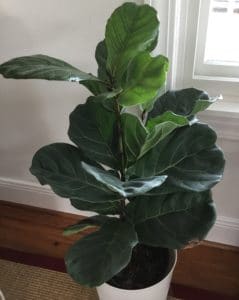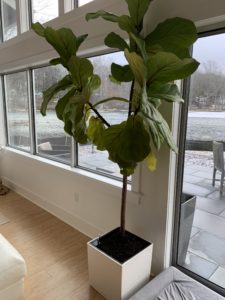Hello, fellow readers, Fiddlehead fig trees (Ficus lyrate), also known as fiddle-leaf figs, grow in rainforests and are native to West Africa, where they grow to forty feet. As a houseplant, they stay shorter, of course, and rarely flower or fruit. They’ve become quite a craze; I found out, and I can see why. Fiddle figs have foot-long leaves (or more) in varying shapes on the same plant. They stand out with noticeable veins and wavy edges. Their leathery silhouette looks like a fiddle, hence the common name.
Yellowing leaves are often a sign of too much water.
“Remember that fiddlehead fig tree you loved?” Suz, a dear client from Sparta, NJ, wrote. “The leaves are turning yellow. I googled it. It said it might need fertilizer. We also ordered a bigger pot, and I’ll replant it with new soil. It gets great light and has been in the same place for two years. Any thoughts?”
Typically, I advise folks not to fertilize indoor plants during the winter when plants are resting, as it can add to plant stress. However, a bit of food may be wise if not fed during the growing season. If Suz’s fig just started turning yellow, it could be a sign of too much water. I suggested a moisture meter probe you can buy for about ten bucks to monitor the wetness of the soil.
It turns out, “The tree is in a Lechuza pot which registers the water, that’s why the yellow leaves are boggling,” Suz said and added, “I gave it some fertilizer recommended for fiddle trees because I didn’t ever fertilize it. I’ll let you know how it does! Thank you got all of your help!”
Self-watering pots keep the soil moist.
I had never heard of her fancy pot made in Germany, though I know about self-watering containers. They’re especially helpful for those often away from home. Or for hot spots on the patio in the heat of the summer. They keep the soil moist no matter the environment.
The thing is, in the winter months, when plants are resting, houseplants are often better watered after the soil goes dry. At least, that’s how I always heard it. Then, there’s the technique of watering with rainwater to offer a nourishing nitrogen boost, which is extremely helpful to indoor plants (see link below).
Fiddlehead fig trees are fickle.
I read fiddlehead fig trees are fickle. They don’t like drafty spots, overly sunny spots, or not enough sun. Nor soil too wet or too dry. And they don’t like dry air. They’re from the rainforest, after all. So, sitting a humidifier nearby during the dry heat in the house time of year makes sense. Perhaps a melody of an old-time fiddle tune, like Tim McGraw’s Where the Green Grass Grows, will help. Being green is good. Garden Dilemmas? AskMaryStone@gmail.com (and now on your favorite Podcast App.)
Click through to learn more about the benefits of Rainwater (& Snow) Harvesting.




